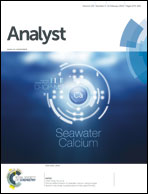Metal–organic framework MIL-101 as a low background signal platform for label-free DNA detection†
Abstract
A label-free and sensitive fluorescence method for recognition of sequence-specific DNA using DNA-intercalating dye and metal–organic frameworks (MOFs) is developed. Here, MIL-101 (Cr3F(H2O)2O[(O2C)–C6H4–(CO2)]3·nH2O) is introduced as a quenching platform to decrease the high background fluorescence of SYBR Green I (SG)/probe DNA complex. Mechanism investigations show that MIL-101 can strongly adsorb the SG/probe DNA complex through π–π stacking and electrostatic interactions, and as a consequence, the fluorescence of the SG dye is greatly quenched. While in the presence of target DNA, the as-formed rigid double-stranded (ds) structure of DNA will be far away from the surface of MIL-101; meanwhile, the SG dye can be bound with the dsDNA in the mode of intercalation and minor groove binding, resulting in enhancement of the SG dye fluorescence. The increased signal-to-background ratio has a linear relationship with the concentration of target DNA in the range of 0.1–14 nM. It is confirmed that the detection limit is 73 pM (3σ), which is much lower than that based on the carbon nanotubes and graphene oxide platform. Moreover, one-base-mismatched target DNA can be discriminated effectively. With the introduction of MIL-101, the signal-to-background ratio has been improved ∼8-fold, demonstrating that MIL-101 is an efficient low-background signal platform.


 Please wait while we load your content...
Please wait while we load your content...